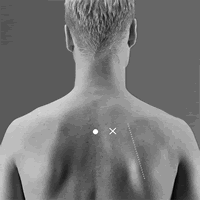|
Muscle
|
||
|
Name
|
Trapezius
|
|
|
Subdivision
|
Transversalis (middle)
|
|
|
Muscle Anatomy
|
||
|
Origin
|
Spinous processes of first through fifth thoracic
vertebrae.
|
|
|
Insertion
|
Superior lip of spine of scapula.
|
|
|
Function
|
With the origin fixed: the transversal fibers perform
chiefly adduction of the scapula (with stabilization by the descending
and ascending fibers).
Stabilization of the rotation of the scapula so the glenoid cavity faces cranially. |
|
|
Recommended sensor placement procedure
|
||
|
Starting posture
|
Erect sitting, with the arms hanging vertically.
|
|
|
Electrode size
|
Maximum size in the direction of the muscle fibers:
10 mm.
|
|
|
Electrode distance
|
20 mm
|
|
|
Electrode placement
|
||
|
- location
|
The electrodes need to be placed at 50% between
the medial border of the scapula and the spine, at the level of
T3.
|
|
|
- orientation
|
In the direction of the line between T5 and the
acromion.
|
|
|
- fixation on the skin
|
(Double sided) tape / rings.
|
|
|
- reference electrode
|
On the proc. Spin. of C7 or on / around the wrist.
|
|
|
Clinical test
|
The elbow extensors and the posterior shoulder muscles
must give necessary fixation in order to use the arm as a lever.
Adduction of the scapula from a position of rotation in which the
inferior angle is rotated laterally. To obtain this position of
the scapula and to obtain leverage for the test, the elbow needs
to be extended and the shoulder placed in 90 degrees abduction and
lateral rotation. This rotation of the shoulder is denoted by the
position of the hand with the palm facing cranially (without elevating
the shoulder girdle).
|
|
|
Remarks
|
The SENIAM guidelines include a separate sensor
placement procedure for the trapezius ascendens and the trapezius
descendens muscle.
|
|
